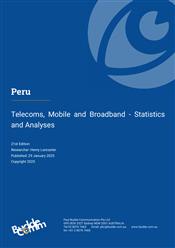Peru Telecoms Market Report
Telecoms, Mobile and Broadband - Statistics and Analyses

Peru cancels tender to manage the RDNFO network
After suffering a sharp retraction in the number of subscriptions and revenue during 2020 due to the pandemic, Peru’s telecom sector managed to stage a small recovery in the first half of 2021. The extent of the decline, however, will take some time to recover from fully. It will likely be two to three years before penetration rates return to the peak levels last seen in 2018. This is especially true given the overwhelming influence of mobile on Peru’s telecommunications market, which now commands almost 95% of all connections.
Peru’s fixed-line teledensity continued its slow but relentless decline into obscurity, dropping below 7% at the end of 2021. Investment in network infrastructure, where it exists, is mainly focused on rolling out fibre cable for fixed broadband services in (mainly) urban areas. Fixed broadband penetration inched higher to reach 8.4% at the end of 2020, a positive result that reflected the shift to working from home during enforced lockdowns at the start of the year. Yet Peru has a relatively low level of computer use, and prices for fixed broadband services are among the highest in Latin America. The overwhelmingly preferred internet access platform will remain the smartphone, with a further 8.6% growth in the number of mobile broadband subscriptions expected in 2021.
One drawback to success in the mobile broadband market was the decision in January 2021 by Google’s parent company Alphabet to shut down Project Loon. This global endeavour involved the use of high-altitude balloons to provide internet access to remote, underserved areas around the world. In Peru, Loon had signed a deal with Telefónica to provide internet services in areas of the Amazon rainforest as part of the Telefónica/Facebook ‘Internet para Todos’ (IPT) project launched in 2018. However, Alphabet was unable to make the venture financially sustainable.
Key developments:
- MTC cancels tender to select a company to operate the RDNFO;
- Claro Peru to see 3,687 mobile towers transferred to a towerco newly set up by América Móvil.
- Regulator fines Movistar and Claro for breaching MNP rules, imposes new requirements on Movistar to provide customers with greater transparency, announces $415 million investment to extend LTE coverage to 2,600 underserved areas.
- MTC issues Fibertel with a 20-year MVNO licence to offer B2B-focused services and dark fibre access over a nationwide fibre network.
- Pacific Cable lands at Lurin.
- Eutelsat Communications enters JV with Telespazio allowing the latter to use Ku Band capacity on the EUTELSAT 117 West B satellite to provide telecom services to 1,300 underserved areas in the Peruvian Amazon.
- Report includes the regulator's market data reports to March 2022, telcos' financial and operating data updates to June 2022, updated Telecom Maturity Index charts and analyses, recent market developments.
Companies mentioned in this report:
Telefónica del Perú (Movistar), América Móvil (Claro Perú), Americatel Perú (Entel), Viettel Peru (Bitel), Gilat To Home Perú, Flash Mobile, Cuy Móvil, Fibertel.
Related Reports
- Latin America - Fixed Broadband Market - Statistics and Analyses
- Latin America - Mobile Network Operators and MVNOs
- Caribbean - Telecoms, Mobile and Broadband - Statistics and Analyses
- Ecuador - Telecoms, Mobile and Broadband - Statistics and Analyses
- Guatemala - Telecoms, Mobile and Broadband - Statistics and Analyses
- Haiti - Telecoms, Mobile and Broadband - Statistics and Analyses
- Argentina - Telecoms, Mobile and Broadband - Statistics and Analyses
- Costa Rica - Telecoms, Mobile and Broadband - Statistics and Analyses
- Uruguay - Telecoms, Mobile and Broadband - Statistics and Analyses
- Brazil - Telecoms, Mobile and Broadband - Statistics and Analyses
Share this Report
TMT Intelligence
A platform to scale your intelligence tasks
Monitor critical insights with our AI-powered Market Intelligence Platform gathering and analyzing intelligence in real time. With AI trained to spot emerging trends and detect new strategic opportunities, our clients use TMT Intelligence to accelerate their growth.
If you want to know more about it, please see:
Research Methodology
BuddeComm's strategic business reports contain a combination of both primary and secondary research statistics, analyses written by our senior analysts supported by a network of experts, industry contacts and researchers from around the world as well as our own scenario forecasts.
For more details, please see:
More than 4,000 customers from 140 countries utilise BuddeComm Research
Are you interested in BuddeComm's Custom Research Service?
Hot Topics
News & Views
Have the latest telecommunications industry news delivered to your inbox by subscribing to BuddeComm's weekly newsletter.